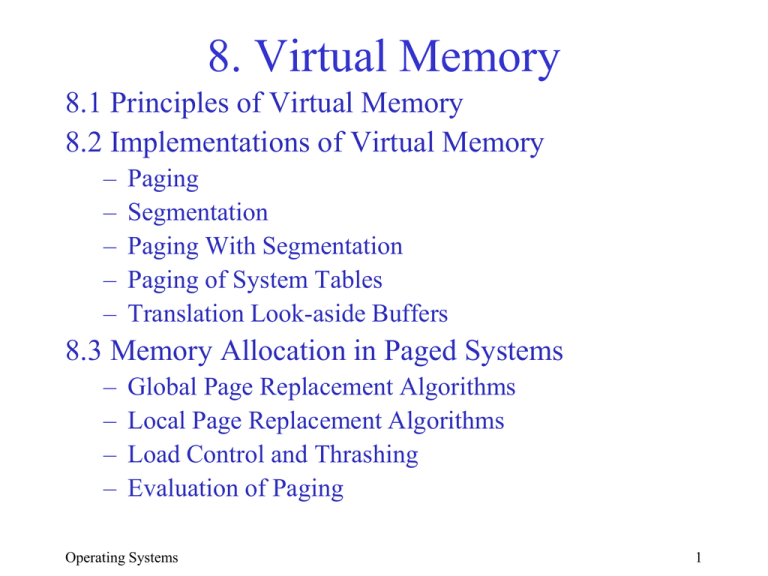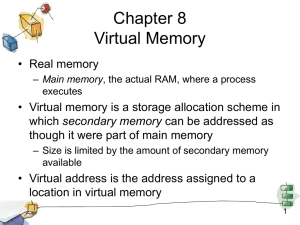8. Virtual Memory
advertisement

8. Virtual Memory 8.1 Principles of Virtual Memory 8.2 Implementations of Virtual Memory – – – – – Paging Segmentation Paging With Segmentation Paging of System Tables Translation Look-aside Buffers 8.3 Memory Allocation in Paged Systems – – – – Global Page Replacement Algorithms Local Page Replacement Algorithms Load Control and Thrashing Evaluation of Paging Operating Systems 1 Principles of Virtual Memory • For each process, the system creates the illusion of large contiguous memory space(s) • Relevant portions of Virtual Memory (VM) are loaded automatically and transparently • Address Map translates Virtual Addresses to Physical Addresses Operating Systems 2 Principles of Virtual Memory • Every process has its own VM • Single-segment VM: – One area of 0..n-1 words – Divided into fix-sized pages • Multiple-Segment VM: – Multiple areas of up to 0..n-1 (words) – Each holds a logical segment (e.g., function, data structure) – Each logical segment • may be contiguous, or • may be divided into pages Operating Systems 3 Main Issues in VM Design • Address mapping – How to translate virtual addresses to physical addresses • Placement – Where to place a portion of VM needed by process • Replacement – Which portion of VM to remove when space is needed • Load control – How much of VM to load at any one time • Sharing – How can processes share portions of their VMs Operating Systems 4 Paged Virtual Memory • VM is divided into fix-sized pages: page_size = 2|w| • PM (physical memory) is divided into 2|f| page frames: frame_size = page_size = 2|w| • Virtual address: va = (p,w) • Physical address: pa = (f,w) – |p| determines number of pages in VM, 2|p| – |f| determines number of frames in PM, 2|f| – |w| determines page/frame size, 2|w| • System loads pages into frames and translates addresses Operating Systems 5 Paged VM Address Translation • How to keep track of loaded pages and translate addresses? Operating Systems 6 Paged VM Address Translation • One solution: Frame Table: – One entry, FT[i], for each frame – records which page it contains FT[i].pid records process ID FT[i].page records page number p – Address translation: • Given (id,p,w), search for FT[f] where (id,p) matches • if matching entry is found then index f is frame number • pa = f + w; Operating Systems 7 Address Translation via Frame Table • Drawbacks – Costly: Search must be done in parallel in hardware – Sharing of pages: not possible Operating Systems 8 Address Translation via Page Table • Page Table (PT) one for each VM (not PM) • Think of PT as array: PT[p]=f page p resides in frame f • Implementation: PT register points at PT at run time • Address translation: pa = *(PTR+p)+w; • Drawback: Extra memory access Operating Systems 9 Example: address translation • Assume: – page size = 512 words – |VA| = 32 bits – |PA| = 24 bits – Translate the following virtual addresses to physical: Page# Frame# 0: 8 1: 4 2: 0 … … 512, 30, 1024 Operating Systems 10 Demand Paging • All pages of VM loaded initially – Simple, but maximum size of VM = size of PM • Pages are loaded as needed: on demand – Additional bit in PT shows presence/absence in memory • Page fault occurs when page is absent – OS is invoked: • If there is a free frame: – load page, update PT • If none available: – replace one (which one? – replacement policy) – save replaced page (if modified) – load new page, update PTs Operating Systems 11 VM using Segmentation • Multiple contiguous spaces: segments – More natural match to program/data structure – Easier sharing (Chapter 9) • Virtual addresses (s,w) must be translated to physical addresses pa (but no frames) • Where/how are segments placed in physical memory? – Contiguous – Paged Operating Systems 12 Contiguous Allocation • • • • Each segment is contiguous in physical memory Segment Table (ST) records starting locations Segment Table Register STR points to ST Address translation: (s,w) pa = *(STR+s)+w; • Drawbacks: – Extra memory reference – Must also check for segment length |w| is only the maximum segment length – External fragmentation (variable partitions) Operating Systems 13 Paging with segmentation • To have multiple segments and fixed partitions: each segment is divided into pages • va = (s,p,w) |s| : # of segments (size of ST) |p| : # of pages per segment (size of PT) |w| : page size • pa = *(*(STR+s)+p)+w • Drawback: 2 extra memory references Operating Systems 14 Paging of System Tables • ST or PT may be too large to keep in PM – Divide ST or PT into pages – Keep track by additional table • Paging of ST – ST divided into pages – Segment directory keeps track of ST pages – va = (s1,s2,p,w) – pa=*(*(*(STR+s1)+s2)+p)+w • Drawback: 3 extra memory references Operating Systems 15 Translation Look-aside Buffer • TLB avoids some memory accesses – Keep most recent address translations in associative memory: (s,p) | f – Bypass translation if match on (s,p,*) – If no match, replace one entry • TLB ≠ cache – TLB keeps frame #s – Cache keeps data values Operating Systems 16 Memory Allocation with Paging • Placement policy: Any free frame is OK • Replacement: – There are many algorithms – Main goal: minimize data movement between physical memory and secondary storage • How to compare different algorithms: – Count number of page faults – Use Reference String (RS) : r0 r1 ... rt … rt is the (number of the) page referenced at time t • Two types of replacement strategies: – Global replacement: Consider all resident pages, regardless of owner – Local replacement: Consider only pages of faulting process Operating Systems 17 Global page replacement • Optimal (MIN): Replace page that will not be referenced for the longest time in the future Time t | RS | Frame 0| Frame 1| Frame 2| Frame 3| IN | OUT | 0| | a| b| c| d| | | 1 c a b c d 2 a a b c d 3 d a b c d 4 b a b c d 5 e a b c e e d 6 b a b c e 7 a a b c e 8 b a b c e 9 10 c d a d b b c c e e d a • Problem: Need entire reference string (i.e., need to know the future) Operating Systems 18 Global Page Replacement • Random Replacement: Replace a randomly chosen page – Simple but – Does not exploit locality of reference • Most instructions are sequential • Most loops are short • Many data structures are accessed sequentially Operating Systems 19 Global page replacement • First-In First-Out (FIFO): Replace oldest page Time t | 0| 1 RS Frame Frame Frame Frame IN OUT 2 3 4 5 6 7 8 9 10 | | c a d b e b a b c d 0|>a|>a >a >a >a e e e e >e d 1| b| b b b b >b >b a a a >a 2| c| c c c c c c >c b b b 3| d| d d d d d d d >d c c | | e a b c d | | a b c d e • Problem: – Favors recently accessed pages, but – Ignores when program returns to old pages Operating Systems 20 Global Page Replacement • LRU: Replace Least Recently Used page Time t | RS | Frame 0| Frame 1| Frame 2| Frame 3| IN | OUT | Q.end | | | Q.head | Operating Systems 0| | a| b| c| d| | | d| c| b| a| 1 c a b c d 2 a a b c d 3 d a b c d 4 b a b c d c d b a a c d b d a c b b d a c 5 e a b e d e c e b d a 6 b a b e d 7 a a b e d 8 b a b e d b e d a a b e d b a e d 9 10 c d a d b b e d c c c d d e c d b c a b e a 21 Global page replacement • LRU implementation – Software queue: too expensive – Time-stamping • Stamp each referenced page with current time • Replace page with oldest stamp – Hardware capacitor with each frame • Charge at reference • Charge decays exponentially • Replace page with smallest charge – n-bit aging register with each frame • Shift all registers to right periodically • Set left-most bit of referenced page to 1 • Replace page with smallest value – Simpler algorithms that approximate LRU algorithm Operating Systems 22 Global Page Replacement • Second-chance algorithm – Approximates LRU – Implement use-bit u with each frame – Set u=1 when page referenced – To select a page: if u==0, select page else, set u=0 and consider next frame – Used page gets a second chance to stay in memory Operating Systems 23 Global page replacement • Second-chance algorithm … 4 5 6 7 8 9 10 … b e b a b c d … >a/1 e/1 e/1 e/1 e/1 >e/1 d/1 … b/1 >b/0 >b/1 b/0 b/1 b/1 >b/0 … c/1 c/0 c/0 a/1 a/1 a/1 a/0 … d/1 d/0 d/0 >d/0 >d/0 c/1 c/0 … e a c d Operating Systems 24 Global Page Replacement • Third-chance algorithm – Second chance algorithm does not distinguish between read and write access • write access is more expensive – Give modified pages a third chance: • use-bit u set at every reference (read and write) • write-bit w set at write reference • to select a page, cycle through frames, resetting bits, until uw==00: uw uw 11 01 10 00 01 0 0 * (remember modification) 00 (select page for replacement) Operating Systems 25 Global Page Replacement • Third-chance algorithm Read → 10 → 00 → Select Write → 11 → 01 → 00* → Select … 0 … >a/10 … b/10 … c/10 … d/10 … IN … OUT | 1 2 3 4 5 6 7 8 9 10 . | c aw d bw e b aw b c d . |>a/10 >a/11 >a/11 >a/11 a/00* a/00* a/11 a/11 >a/11 a/00* | b/10 b/10 b/10 b/11 b/00* b/10* b/10* b/10* b/10* d/10 | c/10 c/10 c/10 c/10 e/10 e/10 e/10 e/10 e/10 >e/00 | d/10 d/10 d/10 d/10 >d/00 >d/00 >d/00 >d/00 c/10 c/00 . | e c d | c d b Operating Systems 26 Local Page Replacement • Measurements indicate that every program needs a minimum set of pages to be resident in memory – If too few, thrashing occurs (program spends most of its time loading/saving pages) – If too many, page frames are wasted • Goal: maintain an optimal set of pages for each process in memory – Size of optimal set changes over time – Optimal set must be resident Operating Systems 27 Local Page Replacement • Optimal (VMIN) – Define a sliding window (t, t+) – is a parameter (constant) – At any time t, maintain as resident all pages visible in window • Guaranteed to generate minimum number of page faults • Requires knowledge of future Operating Systems 28 Local page replacement • Optimal (VMIN) with =3 Time RS Page Page Page Page Page IN OUT t | | a | b | c | d | e | | | 0| d| -| -| -| x| -| | | 1 c x x c 2 c x x - 3 d x x - 4 b x x b d 5 c x b 6 e x x e 7 c x x 8 e x c 9 a x a e 10 d x d a • Unrealizable without entire reference string (knowledge of future) Operating Systems 29 Local Page Replacement • Working Set Model: – Uses principle of locality: near-future requirements are approximated by recent-past requirements – Use trailing window (instead of future window) – Working set W(t,) consists of all pages referenced during the interval (t–,t) – At time t: • Remove all pages not in W(t,) • Process may run only if entire W(t,) is resident Operating Systems 30 Local Page Replacement • Working Set Model with =3 Time t | RS[e,d]| Page a | Page b | Page c | Page d | Page e | IN | OUT | 0| a| x| -| -| x| x| | | 1 c x x x x c 2 c x x x e 3 d x x x - 4 b x x x b a 5 c x x x - 6 e x x x x e 7 c x x x 8 e x x d b 9 10 a d x x - x x - x x x a d . • Drawback: costly to implement • Approximate (aging registers, time stamps) Operating Systems 31 Local Page Replacement • Page fault frequency (PFF) • Conflicting goals of any page replacement policy – Keep frequency of page faults acceptably low – Keep resident page set from growing unnecessarily large • PFF: measure and use frequency of page faults directly • Uses a parameter • Only adjust resident set when a page fault occurs: – If time between page faults (too many faults) • Add new page to resident set – If time between page faults > (could run with fewer) • Add new page to resident set • Remove all pages not referenced since last page fault Operating Systems 32 Local Page Replacement • Page Fault Frequency with τ=2 Time RS Page Page Page Page Page IN OUT t | | a | b | c | d | e | | | Operating Systems 0| | x| -| -| x| x| | | 1 c x x x x c 2 c x x x x 3 d x x x x 4 b x x x b ae 5 c x x x - 6 e x x x x e 7 c x x x x 8 e x x x x 9 10 a d x x - x x - x x x a d bd 33 Load Control and Thrashing • Main issues: – How to choose the degree of multiprogramming? • Each process needs it ws resident to avoid thrashing – When degree must decrease, which process should be deactivated? – When a process is reactivated, which of its pages should be loaded? • Load Control: Policy to set number and type of concurrent processes Operating Systems 34 Load Control and Thrashing • Choosing degree of multiprogramming • Local replacement: – WS of any process must be resident: – Automatic control • Global replacement – No WS concept – Use CPU utilization as a criterion: – more processes increase utilization, but – with too many processes, L=mean time between faults thrashing occurs S=mean page fault service time Operating Systems 35 Load Control and Thrashing • How to find Nmax? – L=S criterion: • Page fault service time S needs to keep up with mean time between page faults L • S is known • Measure L: – if greater than S, increase N – if less than S, decrease N • This effectively implements a PFF policy Operating Systems 36 Load Control and Thrashing • Which process to deactivate – Lowest priority process – Faulting process – Last process activated – Smallest process – Largest process • Which pages to load when process activated – Prepage last resident set Operating Systems 37 Evaluation of Paging • Process references large fraction of pages at the start • Prepaging is important – Initial set can be loaded more efficiently than by individual page faults Operating Systems 38 How large should be a page? • Page size should be small because – Few instructions are executed per page – Page fault rate is better • Page size should be large because they need – Smaller page tables – Less hardware – Less I/O overhead Operating Systems 39 Evaluation of Paging • Load control is important – W: minimum amount of memory to avoid thrashing. Operating Systems 40





